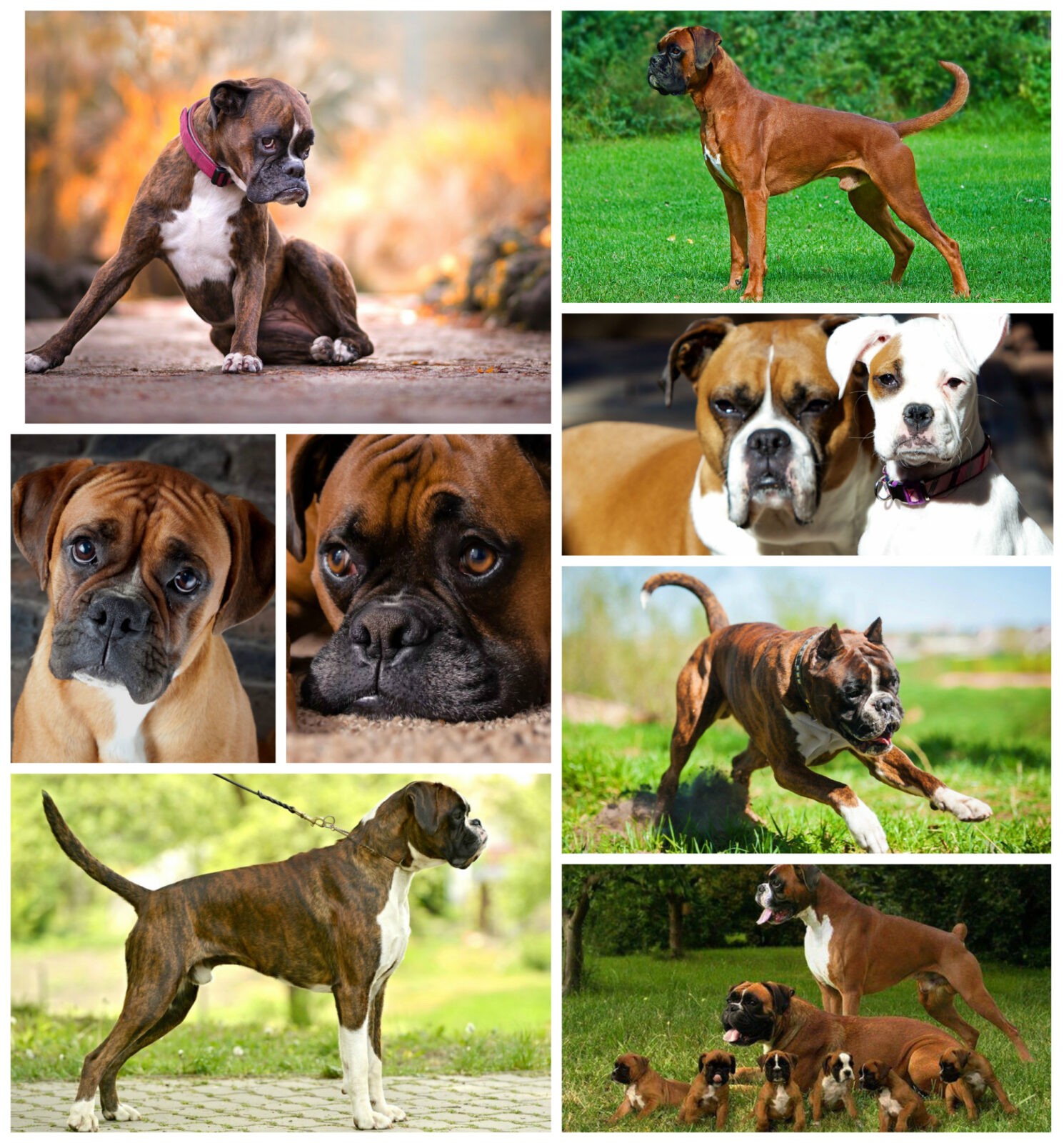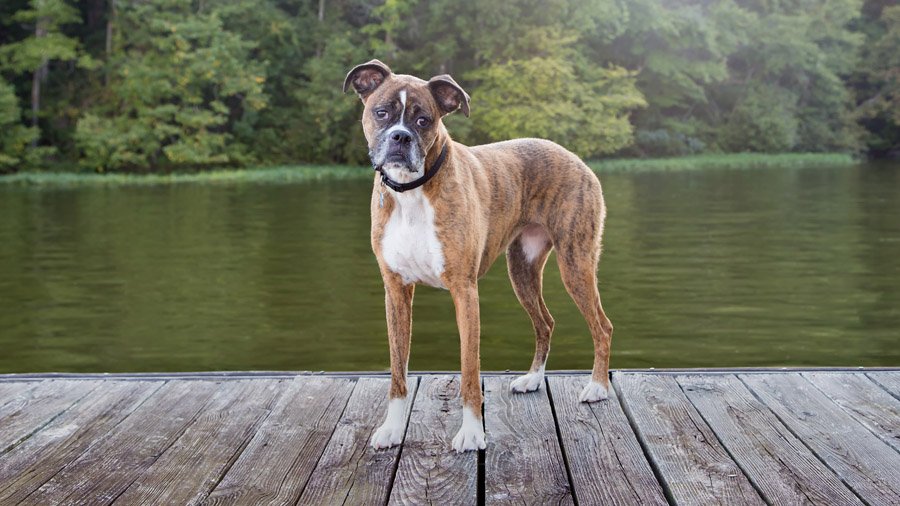Brief description of the boxer breed
The average height of a male at the withers is 58-63 cm, and he weighs an average of 35 kg. The growth of females is 55-60 cm, and the weight is about 30 kg. Boxers were originally bred as guard dogs. Today, these dogs are associated with familiar family pets.
typical boxer - it is a smart, attentive and fearless dog, distinguished by friendliness. She is devoted to her family, loves to play, but at the same time the pet is quite stubborn, especially during training.
Boxers are excellent companions, they are patient and not very demanding of themselves. They show a gentle nature towards children. Main - it is to provide the pet with a sufficient amount of active exercises, and exercises for the development of mental abilities. It is also important to make early socialization of the pet. If you are ready to provide a boxer with enough attention and the necessary amount of physical activity, you can even keep him in a small apartment.
Boxers were bred in Germany, and after the First World War they spread throughout the world. The short, shiny coat may be fawn or brindle, with white patches. Breeding white boxers is undesirable, since this color is mainly caused by genetic abnormalities that lead to deafness. So don't believe dog breeders who try to sell you a white boxer by talking about its unique color!
Most Boxers have docked tails and ears. If the ears are not cropped, they will droop, although many dog breeders prefer not to trim their pet's ears. The issue of cupping is a purely aesthetic component.
Boxers are known for their boundless love for family. Often these dogs are distrustful of strangers, but are not aggressive unless they see a clear threat to themselves or family members.
Boxer owners around the world often marvel at the somewhat roguish behavior of their pet. Such playful behavior - evidence that the animal is in an excellent mood. Often, these dogs play with toys, reminiscent of such behavior cats.
When in an aggressive state, boxers arch their backs in a semicircle. Also, boxers can make rather strange sounds, similar to "woo-woo". Thus, the animal is trying to attract the attention of the owner or family members.
Boxer in a good mood - it's a real spectacle. These dogs can spin, somersault, run in circles, radiating boundless joy and happiness.
Life for a boxer - it's not just games and fun. These dogs have found wide popularity in military affairs. They are used in the army and police, in search and rescue operations. Boxers are often trained to perform guard duties, which, like Mastiffs, they excel at.
Experts do not recommend keeping these dogs outdoors for long periods of time. Their small nose is not able to cool the hot air well in the summer heat, and their short coat does not save them from the winter cold.
Boxers are not a breed that is suitable for everyone, but if you adore gentle dogs that are not averse to drooling, then, in principle, you can get this miracle. - dog. The most important - it is to provide the animal with a sufficient level of physical and mental fitness.
basic information
| Breed name: | Boxer |
| Country of origin: | Germany |
| The time of the birth of the breed: | 1850 |
| Type of: | Molossians |
| The weight: | 30 – 35 kg |
| Height (height at the withers): | 55 - 63 cm |
| Life Expectancy: | 8 – 10 years |
|
ICF classification:
|
Group 2, Section 2, Number 144 |
| Puppies price: | 130 – 1070 $ |
| Most popular nicknames: | list of nicknames for a boxer |
Assessment of breed characteristics
| Adaptability
(a definition meaning how easily a dog can adapt to changes in life) |
🐶🐶🐶🐶 |
| Shedding level
(Level and frequency of hair loss in the animal) |
🐶🐶🐶 |
| Tenderness level
(The level and amount of tenderness and affection that the dog gives in return for attention to itself) |
🐶🐶🐶🐶🐶 |
| Exercise needs
(Dog's daytime activity level) |
🐶🐶🐶🐶🐶 |
| Social need
(The required number of contacts of the dog with other animals, as well as people) |
🐶🐶🐶🐶🐶 |
| Apartment content
(A factor that determines the level of noise and other inconveniences that a dog can deliver to owners in relation to the size of the apartment to the size of the dog) |
🐶🐶🐶🐶 |
| Grooming
(The number of bathing, brushing, and the number of professional grooming sessions required for the dog) |
🐶 |
| Friendliness in an unfamiliar environment
(Features of the behavior of a dog in a society with strangers or in an unfamiliar environment) |
🐶🐶🐶 |
| Tendency to bark
(Tendency to bark and its frequency and volume) |
🐶🐶 |
| Health issues
(Potential health status of the dog) |
🐶🐶🐶 |
| Territoriality
(The dog's tendency to protect his home, yard, or even his owner's car) |
🐶🐶🐶🐶🐶 |
| Friendliness to cats
(The tendency towards tolerance for cats and decreased manifestation of hunting instincts) |
🐶🐶🐶 |
| Intelligence
(The ability of the dog to think and solve emerging difficulties (not to be confused with learning!) |
🐶🐶🐶🐶🐶 |
| Education and training
(The level of difficulty in training the dog to perform certain actions) |
🐶🐶🐶 |
| Friendliness to children
(A factor that determines how friendly a dog is to children, whether he likes to play with them and tolerate some childish pranks) |
🐶🐶🐶 |
| Game activity
(The concept is determined by its very name, and, as a rule, is found in almost all dogs) |
🐶🐶🐶🐶 |
| Observation
(The ability of a dog to detect the presence of a stranger on its territory) |
🐶🐶🐶🐶🐶 |
| Friendliness to other dogs
(The tendency of the dog to find common language with his other relatives) |
🐶🐶 |
Boxer photo:

Origin story
Boxers - these are the descendants of German bullenbeisers (dogs descended from bulldogs). Bullenbeisers were used as hunting dogs for many centuries. They hunted bears, deer and wild boars. The task of the dog was to catch and hold the prey until the hunters arrived. Over time, the bullenbeiser began to be used by farmers and butchers to guard livestock.
Today it is known for sure that the boxer was bred at the end of the 19th century. A resident of Munich, Georg Alt, who bred Bullenbeisers, crossed the dog with a pet (of an unknown breed) of a certain townswoman named Flora. As a result, a dog was bred, which was named Lechner Box. This is the starting point in boxer breeding. Later, Lechner Box was crossed again with Bullenbeiser. Although the dogs resulting from such crosses did not bear much resemblance to modern boxers, research shows that these animals are the progenitors of the boxer.
Photographs of the Boxer's ancestors first appeared in John Wagner's The Boxer, which was first published in 1939. It is here that it is said that the Boxer was bred as a result of crossing a Bullenbeiser with a dog of an unknown breed, which belonged to a woman from Munich named Flora. The dog obtained as a result of crossing was of small stature, brindle color with white patches.
In 1894, three Germans: Robert, Koenig and Hopner decided to bring the breed to the light and decided to show it at a dog show. This happened in Munich in 1895, and the very next year the world's first boxer fan club was organized.
Boxer character
Maintenance and care
Boxers have a short coat, so grooming a dog is not very difficult. Boxer is very clean, for which he is often compared with cat. In order to keep the coat in good condition, one weekly combing is enough. Bathe dogs of this breed only as needed, usually once every three - four months.
Dog teeth require careful care. Experts say that weekly brushing of teeth will be enough to prevent the occurrence of tartar and gum disease. This procedure will also help prevent bad breath from the animal.
Ears require special attention. They should be carefully inspected every week for irritation, infection, or inflammation. Treat the ears with a special solution on the recommendation of a veterinarian. Nails are trimmed as needed.
Training and education
Health and disease
The average life expectancy of a boxer is 8-10 years. Representatives of this breed are not very adapted to life in climates with sudden changes in temperature. Historically, Boxers have been required to have cropped ears and tails. Although the breed standard does not require ear docking, the same cannot be said for the tail, which is mandatory.
The main health problems that can occur in a boxer include: allergies, bloating, cardiomyopathy, sick sinus syndrome, padodermatitis, follicular dysplasia, brachiocephalic syndrome, ear infections, epilepsy, hip dysplasia, hypothyroidism, insulinoma, pyloric stenosis, histiocytic colitis , congenital dislocation of the elbow, melanoma, cutaneous histiocytoma, sensory neuropathy, volvulus, ectropion, cherry eye, corneal ulceration, cryptorchidism, sarcomas, and subaortic stenosis.
Some interesting facts
- Boxers are very energetic, so they need a lot of active exercise. You must be sure that you have enough time and desire to take care of the dog and provide it with the necessary amount of training.
- Early training is very important for training this dog. In adulthood, it is almost impossible to train a dog.
- Although the boxer gives the impression of a strong dog, but its physiological characteristics cause intolerance to heat and cold. That is why dogs of this breed must be kept only in the house.
- Boxers mature very slowly, so they can behave like puppies for several years.
- Boxers do not just love to be with their families, it is their natural need. If the dog is left alone for a long time, then the animal will begin to show aggression.
- Boxers are among those breeds that have an active salivation.
- Although boxers have short coats, they are prone to shedding, especially in spring.
- Boxers are easy to train. But due to the fact that these dogs clearly show a stubborn nature, it is necessary to show perseverance during training and education.
- Boxer can become an excellent guard.
- In order to become owners of a healthy puppy, you do not need to purchase it from random breeders or pet stores.
Nurseries and breeders
We borrowed material from the wonderful site of our partners DOGCATFAN.COM


